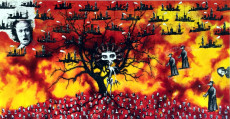
Friedrich's sublime and tragic mood

About the exhibition “Caspar David Friedrich – Art for a New Age”, visible until April 1 at the Kunsthalle in Hamburg (Germany).
It's funny. I had always thought that this well-dressed man, elegantly perched on a rocky promontory facing the fog, with tousled hair, was Chateaubriand. Yes, the writer François-René vicomte de Chateaubriand, born in Saint-Malo in 1768, died in Paris in 1847, whose political ideas had hardly mattered to me in my youth but who had surreptitiously embodied romanticism in my unconscious, with his famous Memoirs from Beyond the Grave. I only now understand that the painting by Caspar David Friedrich entitled “Wandering over the Sea of Fog” (in literal translation) must have simply served as an illustration for the cover of a copy of the literary work posthumous having landed in my hands as an exalted teenager. “The absolute solitude, the spectacle of nature, soon plunged me into a state almost impossible to describe. Without parents, without friends, so to speak, on earth, having not yet loved, I was overwhelmed with a superabundance of life. Sometimes I blushed suddenly, and I felt like streams of fiery lava flowing through my heart; sometimes I uttered involuntary cries, and the night was equally disturbed by my dreams and my waking hours. I lacked something to fill the abyss of my existence: I descended into the valley, I rose on the mountain, calling with all the force of my desires the ideal object of a future flame; I kissed it in the winds; I thought I heard it in the groans of the river; everything was this imaginary ghost, and the stars in the heavens, and the very principle of life in the universe. »
Brief. This year's masterful celebration of the 250th anniversary of Caspar David Friedrich (1774-1840), this German painter and draftsman considered the most important and influential artist of German romantic painting, is today collapsing the entire myth that I had unconsciously built around this beautiful, disheveled Chateaubriand. And that's so much the better, because in reality this royalist viscount intended no less "to denounce this kind of new vice (meaning daydreaming) and to paint (through his writings) the disastrous consequences of the exaggerated love of solitude" . Let's go! If we can no longer even dream, where are we going... So here I am delighted to now put another name on this splendid painting, more precisely entitled in French "The Traveler contemplating a sea of clouds". Caspar David Friedrich. At least he was just asking for the solitary viewer of his works of art for sale to travel far away in thought. Emphasizing “mood”, or “stimmung” in German, the way in which the landscape can influence our mood and, conversely, the way in which our mood can influence the way we look at a landscape.
As a 19th century whistleblower, he concealed in his “romantic” landscape painting, to whom Hitler gave so much of the good God without confession that his work had been completely appropriated by the Nazis, a reality which recalls to us today with all the violence of global warming: man has always wanted to dominate nature. Even if it means crushing it to satisfy its needs for unlimited expansion. But damaged nature will survive. More surely than man.
We understand better why his terrifying Sea of Ice, an oil on canvas painted in 1823-1824, remained on his hands. “The painter had certainly carried out small studies when the Elbe froze during the winter of 1820-1821. But its vast format, totally occupied by improbable geometric piles of ice blocks, is a pure product of his imagination. Too modern in its time, the work never found a buyer,” writes journalist Sophie Flouquet in the February issue of Beaux Arts Magazine, which devotes ten superb pages to Caspar David Friedrich on the occasion of the exhibition which opens the ball at the Kunsthalle in Hamburg, until April 1, before a next episode of the Friedrich festival at the Alte Nationalgalerie in Berlin, then at the Staatliche Kunstsammlungen in Dresden, which will further explore the biography and influence of the painter. Certainly, the work of art for sale was too modern for the time. But in my opinion, it was above all the kind of work of art far too anxiety-provoking to be purchased by collectors or art dealers at the height of German romanticism. Despite all its pictorial qualities, it was not likely to panic the 19th century contemporary art market. With the remains of the ship engulfed in an apocalypse setting, it is impossible to look into it without being engulfed yourself. Frozen. “In a quest to chart a route to America from the north, many ships were shipwrecked in the ice at the time,” explains Markus Bertch, curator of the Hamburg exhibition “Caspar David Friedrich – Art for a New Age.” So, certainly, “this painting bears witness to this in its own way and invites us to be wary of the forces of nature. But in the fear it arouses, there is perhaps also this tragic memory where, having fallen as a child into the icy waters of the Baltic, young Friedrich was saved by his brother Johann who drowned. » What do you mean, maybe? Definitely yes!
We suddenly understand better why the shadow of death ultimately lurks over all works of art by Friedrich. Why the German master of pictorial romanticism was able to be the precursor of the representation of a face-to-face encounter between man and nature that is as mystical as it is tragic, as presented by Sophie Flouquet in the opening of her article for Beaux Arts Magazine. The vast exhibition in Hamburg, where two hundred works including 180 by the painter, more than 60 paintings and incredible drawings are brought together around his definition of the sublime and mystical landscape, masterfully explores the meanders of a thought anticipating the Anthropocene, our geological era marked by the global consequences of human activities on the biosphere. This new contemporary era during which man has turned everything upside down, which inspires contemporary art so much, and which generally begins with the industrial revolution of the 18th century. Moreover, the works of around twenty contemporary artists such as Kehinde Wiley, Elina Brotherus, Mariele Neudecker, Jonas Fischer and Jochen Hein complete the exhibition.
Friedrich was not a seer. He simply knew viscerally that nature always prevailed. And as a man of the 18th century, inevitably inhabited by religion, he had chosen to give a divine dimension to nature. The Beaux Arts Magazine file opens with a full-page reproduction of Winter Landscape with Church, and the question is asked straight away: “Out of the fog emerges the hand of man, builder of proud cathedrals; from nature emerges that of God, with this crucifix stuck at the foot of a majestic fir tree. Is it better to believe in the destructive force of man or in the divine force of nature? »
 Article written by Valibri in Roulotte
Article written by Valibri in Roulotte
Illustration: CASPAR DAVID FRIEDRICH (1774-1840)
Hikers above the sea of fog, circa 1817





































































